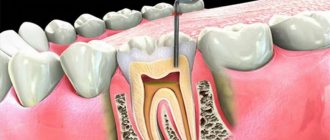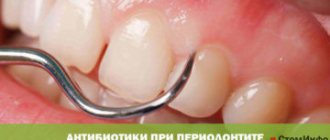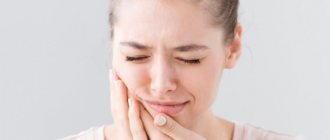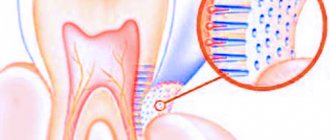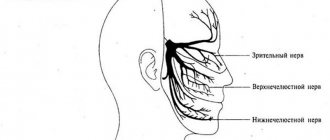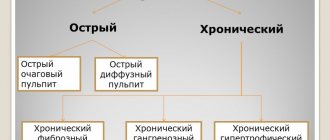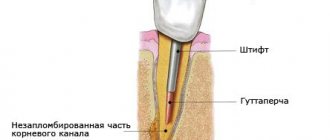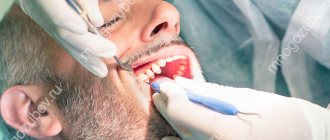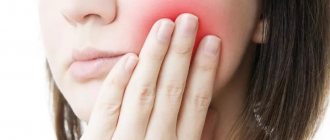From this article you will learn:
- why does a tooth hurt after pulpitis treatment,
- what to do if a tooth hurts after pulpitis treatment,
- What are the complications after treatment of pulpitis?
Pain after treatment of pulpitis can in some cases be natural, and also be the result of gross mistakes by the dentist. Here we should cite indicative official statistics - in 60-70% of cases, pulpitis is treated poorly, which leads to various complications and tooth loss.
After treatment of pulpitis, it is mandatory to take a control x-ray, which shows how well or poorly the filling was done. However, statistics show that seeing the shortcomings of the treatment performed in the control image, most dentists do not seek to redo the poor-quality work.
What can hurt after filling?
The pain associated with the installation of a filling directly depends on the structure of the tooth. It consists of a crown, neck and root. On top, all these structures are covered with hard dental tissues that do not have nerve endings. In the crown area it is dentin and enamel, in the root area it is cement. Inside, under the hard covering in the crown area, there is a dental cavity filled with pulp - a pulp that has many nerve endings and blood vessels. The cavity is connected to root canals, also filled with pulp. In the area of the apex (apex), the root is connected to the bone tissue of the jaw using a ligament - the periodontal ligament, which has excellent innervation.
Conclusion: a tooth can only hurt if the pulp and periodontium are diseased or injured.
Canal cleaning and filling
The most common cause is caries - a pathological process accompanied by the destruction of hard dental tissues. This opens access to the dental cavity, root canals and periodontal tissue, inflammation or irritation of which causes severe pain.
Preparing a tooth for filling
Filling is a method of treating caries, but this process itself can cause mechanical irritation of soft tissues, accompanied by pain. Minor pain may be normal, but sometimes you cannot do without the help of a specialist.
In the superficial and middle stages of caries, the affected hard tissues are removed and a filling is placed on top, restoring the shape of the tooth. The dental cavity remains closed. This treatment is absolutely painless and does not require anesthesia. An even more effective way is to have your teeth professionally cleaned to remove plaque and tartar. Regular implementation of this procedure prevents the development of caries and allows you to keep all your teeth healthy for a long time.
Tooth preparation and depulpation
With deep caries, a hole forms in the hard tissues and an infection enters the dental cavity, causing intense pain. In such cases, before filling, preparation is carried out to remove damaged hard tissues and expand the cavity. If necessary, the old filling is also removed. Then the pulp is removed (depulping).
This is a painful procedure, but modern local anesthetics used in dentistry allow the patient to experience no pain at all. If deep caries has developed not so long ago, and the periodontal tissues are healthy, then it is possible to remove only the pulp from the dental cavity (amputation), after which a therapeutic lining is applied and a temporary filling is installed. If there is no pain, a permanent filling is placed after a few days.
In case of long-standing caries, the pulp is first completely removed from the dental cavity, and then from the root canals (extirpation). At the same time, the cost of filling increases.
It is very important to carefully remove the pulp (patients often call it the nerve) from the canal, making sure that no particles of destroyed hard tooth tissue remain in it. All this can support a long-term inflammatory process.
If a tooth hurts after canal filling, the infection can gradually reach the root apex, causing an inflammatory process in the periodontium, accompanied by fever and pain.
Causes of post-filling pain syndrome
If a tooth hurts under a filling, there are usually natural reasons for this - irritation and even a slight aseptic (without infection) inflammatory process. The tooth should hurt after filling. Pain appears after the anesthetic wears off and is associated with restoration of tissue sensitivity. Each patient’s pain sensitivity threshold is different: one feels almost no discomfort, while another perceives the same pain as severe.
Depending on the degree of destruction of the crown and the filling work performed, unpleasant painful sensations after the end of anesthesia can last from 5 days to several months. The doctor must warn the patient that he may be bothered by painful sensations for a certain time and how to cope with them.
There is no need to see a dentist if the pain:
- has a moderate aching character, lasts no more than 5 days and its intensity gradually decreases; during root canal treatment, pain can last from a week to a month; if the filling was traumatic, it may last even longer;
- appears or intensifies when pressing on the filling - biting on solid food;
- associated with eating irritating foods - too cold or hot, as well as sour or sweet; after the effect of irritation ends, the intensity of painful sensations decreases;
- associated with hypothermia;
- is not accompanied by swelling of the cheeks, increased body temperature and a violation of the general condition.
Pain associated with filling errors
Common mistakes: perforation of the root canal and entry of a foreign body into the root canal.
Post-filling pain syndrome can also be associated with medical errors. This:
- Lack of x-ray examination at the very beginning, before filling . The tooth may have structural features: tortuous canals, the presence of additional canals, etc. Without X-rays, the doctor will not be able to properly process and seal it. This is where the answer to the question of why a tooth hurts after root canal filling lies.
- Incorrect (insufficient or excessive) drying of the prepared cavity . Drying is necessary so that the application of a special solution promotes tight adhesion of the filling material to the dentin of the dental cavity. Insufficient drying leads to disruption of this adhesion, the filling will not fit tightly to the walls, infection will penetrate into the cavity, and inflammation will begin. Overdrying is also harmful, it increases the sensitivity of tissues and post-filling pain syndrome will persist for a long time.
- Overheating of dental tissues. Most often, this complication occurs when the dentist works on old equipment. Tooth preparation is accompanied by strong heating of the bur. If you do not frequently cool the dental tissues, a burn of the pulp or dentin is possible, accompanied by severe pain. Tissue burns are also possible when filling using light-curing filling material and outdated ultraviolet lamps that have not been used for a long time. Modern halogen systems for light curing do not give rise to such complications.
- Failure to comply with preparation rules. Leads to infection, the development of pulpitis and periodontitis and associated pain, which intensifies when biting solid food; perforation may occur:
- walls or bottom of the dental cavity; this complication occurs when the walls of the carious cavity are excessively prepared; the bottom of the cavity is most often perforated due to insufficient preparation of the walls, the inability to see and properly process the mouths of the root canals;
- walls of root canals - perforation is usually associated with instrumental treatment of difficult tortuous canals. To reduce pain, you will need to apply therapeutic bandages and completely re-treat the tooth.
- Incomplete pulp removal. If after filling a tooth “the nerve hurts,” it means that the treatment was carried out poorly. An inflammatory process begins in the soft dental tissues, accompanied by severe pain. To prevent this from happening, the pulp is carefully removed, followed by treatment of the cavity and canals with an antiseptic.
- Insufficient preparation of the carious cavity . Repeated tissue damage by caries usually develops when the affected hard and soft tissues are removed.
- Entry of a foreign body into the root canal. It could be:
- a fragment of a tool used to clean the canal;
- dentin sawdust formed during the preparation of the dental cavity; they clog the mouth of the root canal, which interferes with its processing and contributes to the development of the inflammatory process.
- Incorrect calculation of the shrinkage coefficient of the filling material . Shrinkage and depressurization of the filling can also cause tooth pain after filling. When curing (including light curing), filling material may slightly decrease in volume. This is called shrinkage; the dentist must take into account the shrinkage coefficient of the material used (how much and after what time it will lose volume). If this is not done, over time a gap will appear between the filling and the hard tissues, where infection can enter. This will lead to the development of pulpitis and periodontitis. If depressurization occurs, the old seal is replaced with a new one.
- The filling is too high, leading to malocclusion. When it comes into contact with antagonist teeth on the opposite jaw after filling, tooth pain appears when biting. To eliminate pain, you need to carefully sand the new filling and remove excess filling material. If this is not done, the pain will be constant.
- Excessive introduction of filling material into the root canal. This leads to its extrusion through the top of the tooth and injury to the periodontium. Periodontitis develops. To reduce pain, it is necessary to conduct x-ray diagnostics and eliminate the identified defect.
- A cyst or granuloma of the root after poor-quality filling of the root canals and the development of an inflammatory process in them. Gradually, the inflammation becomes chronic and leads to the development of a granuloma (an overgrowth of loose granulation tissue) or a cyst (a sac filled with inflammatory exudate). The pain syndrome is a constant concern and is chronic in nature. It is impossible to do without surgical intervention - removal of tumors.
- Allergic reaction to filling material. The onset of an allergy is manifested by pain and swelling of the periodontal tissues. This often causes a headache. Immediate removal of the filling is required.
To determine why a tooth hurts after filling, specialists at the YuliStom clinic first conduct diagnostics (thorough examination and x-rays) and only then treat.
What is pulpitis
Pulpitis is an inflammatory process inside a tooth. It passes through the neurovascular bundle - the pulp. This is a soft tissue that runs through the entire tooth and helps provide it with proper nutrition. It is reliably protected from external influences by dental bone tissue, but any violation of its integrity leads to severe pain and inflammation.
At an early stage, the disease can still be cured, but if this is not done, the infection can spread to the bone tissue, resulting in periodontitis. And this is not just a word or pain, it is a high risk of tooth loss. Dangerous bacteria will literally destroy the nerve, forming a large amount of pus. Because of this, gumboil develops and the sore spot becomes very swollen and painful. And in such cases it is no longer possible to do without the help of a surgeon. To prevent this from happening, pulpitis must be treated at the earliest stages. But how not to confuse it with other dental diseases?
Options for relieving post-filling pain
If a tooth begins to hurt due to a filling being placed, but its condition does not require additional dental procedures to reduce the sharp pain, the doctor may prescribe:
- painkillers ; most often these are drugs from the group of non-steroidal anti-inflammatory drugs (NSAIDs); Ketoprofen (Ketonal) has the best analgesic properties; in case of severe pain, it is enough to take a long-acting capsule of 150 mg - these will relieve pain for a day; instead of Ketonal, you can use the rectal suppository Diclofenac - 100 mg; both drugs are contraindicated in the presence of a gastrointestinal ulcer; in such cases, it is better to take a nimesulide tablet (Nise) - it has almost no negative effect on the gastrointestinal tract;
- physiotherapeutic procedures - to reduce pain, electrophoresis with novocaine is prescribed; for swelling, it is better to use hydrocortisone instead of novocaine; Magnetic and laser therapy are also used; the number of procedures depends on the patient’s condition;
- a one-time injection of an antibiotic solution into the periodontal tissues - for problematic traumatic treatment to prevent infectious inflammation and pain.
There are many folk recipes for relieving severe post-filling toothache:
- rinsing the mouth with a decoction of oak bark; Pour 2 tablespoons of crushed bark into a glass of water, bring to a boil, boil for 15 minutes, add boiled water to the original volume, strain and rinse your mouth several times a day; when a tooth hurts, it relieves inflammation, swelling and associated pain well;
- applying a small piece of salted (but not smoked) lard to the gum - this application is especially helpful for pain associated with tissue swelling: salt draws fluid from the tissue, swelling and pain go away;
- a reflex method of pain relief (used in folk medicine for a very long time): grate a clove of garlic on a fine grater, place it in a thin napkin, apply it to the inside of the wrist of the hand opposite the painful tooth, fix it and leave it overnight.
Should I tolerate post-filling pain or not?
My tooth hurts under a filling, what should I do? First of all, do not panic, but calmly understand the situation. If a tooth hurts after a filling, the nature of the pain and the appearance of some other symptoms matter.
Tooth hurts under temporary filling
The intensity of pain under a temporary filling should gradually decrease.
Can a tooth hurt under a temporary filling? Of course, it can, but natural pain is not severe, and its intensity gradually decreases. The tooth hurts after filling, mainly during the day, when it is subjected to one or another impact - pressure (chewing hard food), drinking hot, cold or sour drinks.
Possible reasons
Most often, this is normal; the tooth begins to ache for natural reasons. Painful sensations can also occur due to overheating of tissues during preparation, light-curing of fillings, problems with drying the dental cavity after preparation, or fillings that are excessive in height.
What's the best way to relieve pain?
For natural pain and pain associated with minor violations of the treatment process, it is enough to rinse your mouth with an infusion of chamomile flowers and take an anesthetic (Analgin, Pentalgin, Nise).
Acute pain after filling
Very often, a tooth hurts after root canal cleaning and filling. The acute nature of the pain syndrome is associated with injury or inflammation of sensitive tissues - pulp or periodontium. Much also depends on the pain sensitivity of the patient himself.
Possible reasons
Incomplete removal of pulp from the tooth cavity.
What's the best way to relieve pain?
Take painkillers and see a dentist.
Throbbing pain after filling
If the tooth hurts severely after filling, the pain has become throbbing, then this is a sign of inflammation of the pulp - pulpitis. A sharp headache often appears.
Possible reasons
The cause of pulsating pain syndrome may be poor-quality treatment of the dental cavity and root canals, possibly perforation of the walls.
What's the best way to relieve pain?
Take any painkiller orally and immediately contact your dentist.
Only a dentist can relieve throbbing pain
Aching pain after filling
When a tooth aches after a filling is placed, this is normal. How long a tooth hurts after canal filling depends on the complexity of the manipulations performed. The intensity of the pain is important: if it increases, the pain intensifies sharply when pressed, then this is a symptom of incipient inflammation. A decrease in intensity is a favorable sign.
Possible reasons
This is natural pain in a filled tooth.
What's the best way to relieve pain?
Rinse with a decoction of oak bark or an infusion of chamomile flowers. If the pain seems too severe, take a pain reliever.
Pain when pressing
If a tooth hurts after a filling when you bite it, then most often it has natural causes and goes away in five to seven days.
Possible reasons
If, after filling, a tooth hurts when pressed, then most often this is a consequence of treatment and injury to dental tissues.
What's the best way to relieve pain?
Temporarily avoid chewing food on the side of the filling, rinse your mouth with light antiseptics and herbal decoctions.
Complications after treatment of pulpitis: summary
The consequences of pulpitis (or rather the consequences of its poor treatment) can be the following:
- Situations when root canals are not filled enough lead in 100% of cases to the development of periodontitis, radicular cysts, gumboil, etc.
- Refilling root canals can lead to long-term pain and even neuralgia.
- Pulpitis - tooth extraction... if during the treatment of pulpitis the doctor allowed perforation or fracture of the tooth root, then without appropriate treatment this will lead to tooth extraction as soon as possible after treatment. If, after treatment of pulpitis, a cyst appears, this can also lead to tooth extraction (only at a later date). We hope that our article on the topic: What to do when a tooth hurts after pulpitis treatment was useful to you!
Sources:
1. Higher prof. the author’s education in therapeutic and surgical dentistry, 2. Based on personal experience as a dentist, 3. National Library of Medicine (USA), 4. “Therapeutic dentistry: Textbook” (Borovsky E.), 5. “Practical therapeutic dentistry” (Nikolaev A.).
When you need to urgently go to the clinic
Occasionally, a filling can create serious problems that require immediate attention to your dentist:
- gum pain after tooth filling; if the pain does not increase, then this is a variant of the norm; but often the pain syndrome is accompanied by redness and swelling of the mucous membrane, the appearance of pus when pressing on the gums, which indicates the presence of an inflammatory process; it could be a burn to the gum tissue, an allergy to the filling material, or an infection; in any case, you need to contact a specialist;
- a toothache and a sharp rise in body temperature to high numbers or a slight increase lasts more than three days, a severe headache appears;
- the cheek on the side of the filling became swollen and pain of any nature, increasing in intensity, appeared in the tooth or periodontal tissues.
Don't put off visiting the dentist if your cheek is swollen or you have a fever!
Features of periodontitis treatment
With periodontitis, the inflammatory process often spreads to the entire ligamentous apparatus of the tooth. The disease is often complicated by an abscess, so its treatment is a difficult task. It is aimed at eliminating pain and eliminating the source of inflammation. As a rule, doctors perform the following manipulations:
- remove accumulated exudate,
- thoroughly clean the root canals,
- treat them with medications,
- filled with filling material.
When choosing treatment tactics, the form of the disease, the degree of pathological changes and the clinical picture are taken into account.
Prevention
The risk of tooth pain after a filling is installed can be reduced if you follow all the dentist’s recommendations for oral care.
What not to do before filling
When planning a visit to the dentist, you need to:
- choose the most suitable time so that you can rest after the filling is placed;
- eat, as you will not be able to eat immediately after treatment;
- Do not drink alcoholic beverages under any circumstances, as they may have undesirable reactions with the painkillers used during treatment;
- Brush your teeth thoroughly and rinse your mouth with an antiseptic solution, such as mouthwash.
You should not plan to place a filling during any acute illness or exacerbation of some chronic disease.
What not to do after filling
It is important to adhere to the following tips:
- do not eat or drink for two hours;
- try to avoid chewing on the affected side of solid food;
- do not eat too hot or cold food for 5 – 7 days;
- avoid coloring products that can change the color of the filling material (beets, red wine, etc.);
- brush your teeth only with a new soft toothbrush twice a day;
- use an alcohol-free mouth rinse;
- do not use dental floss to remove food debris; it is better to replace them with a new product - an irrigator.

